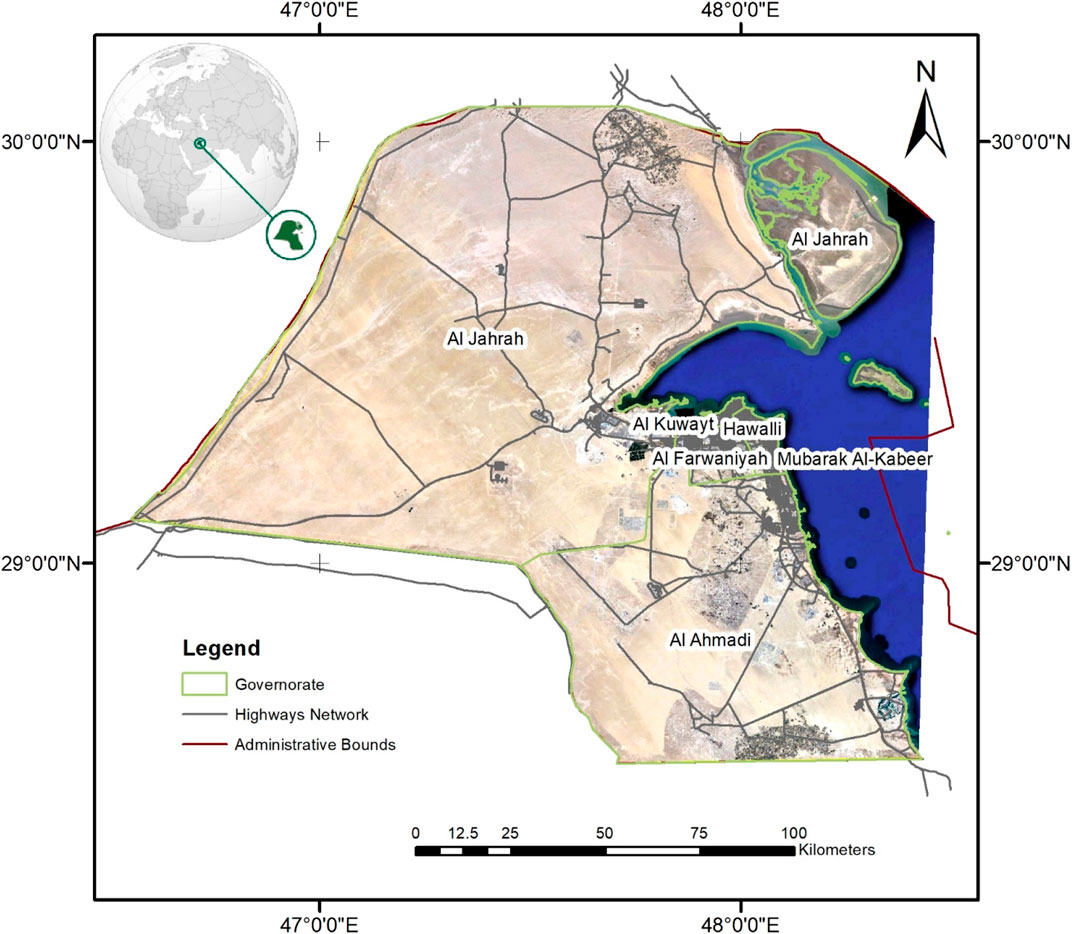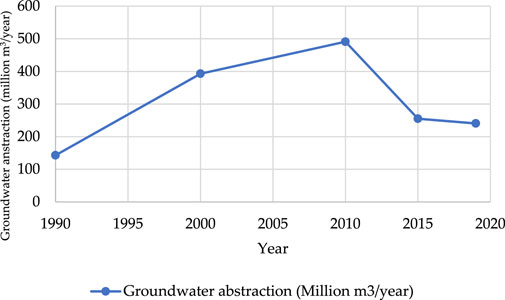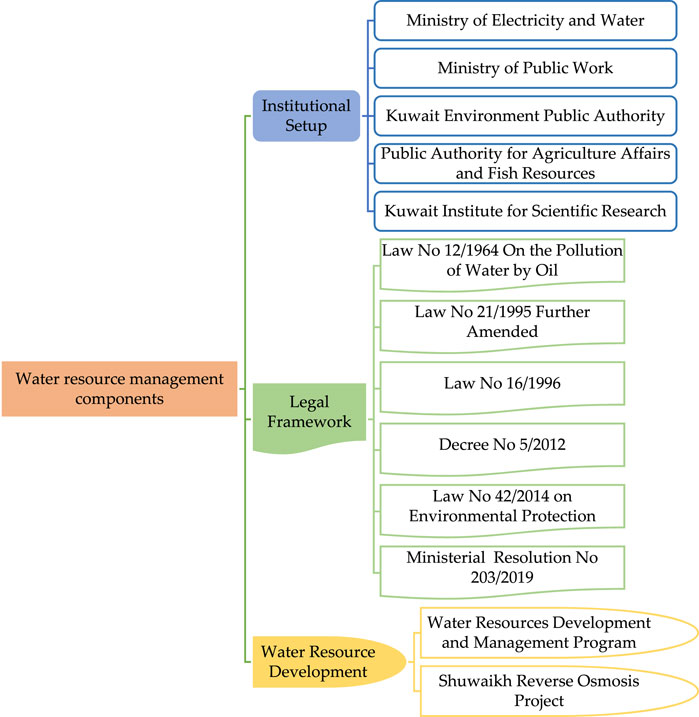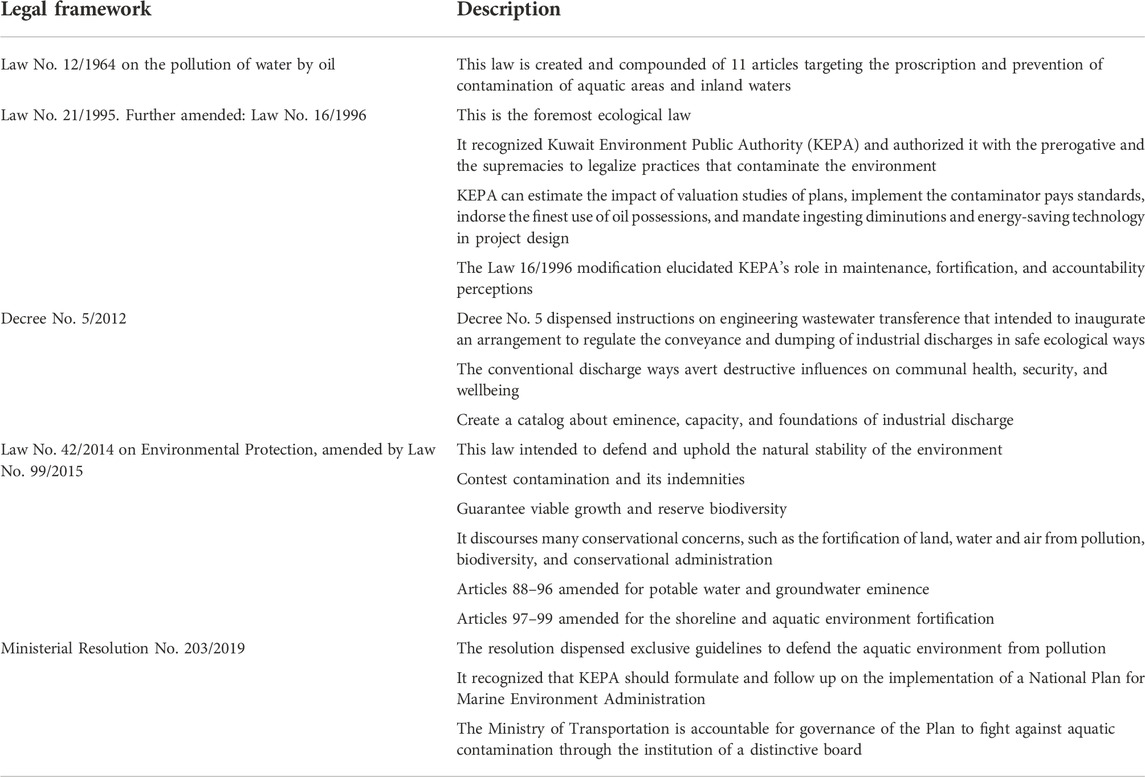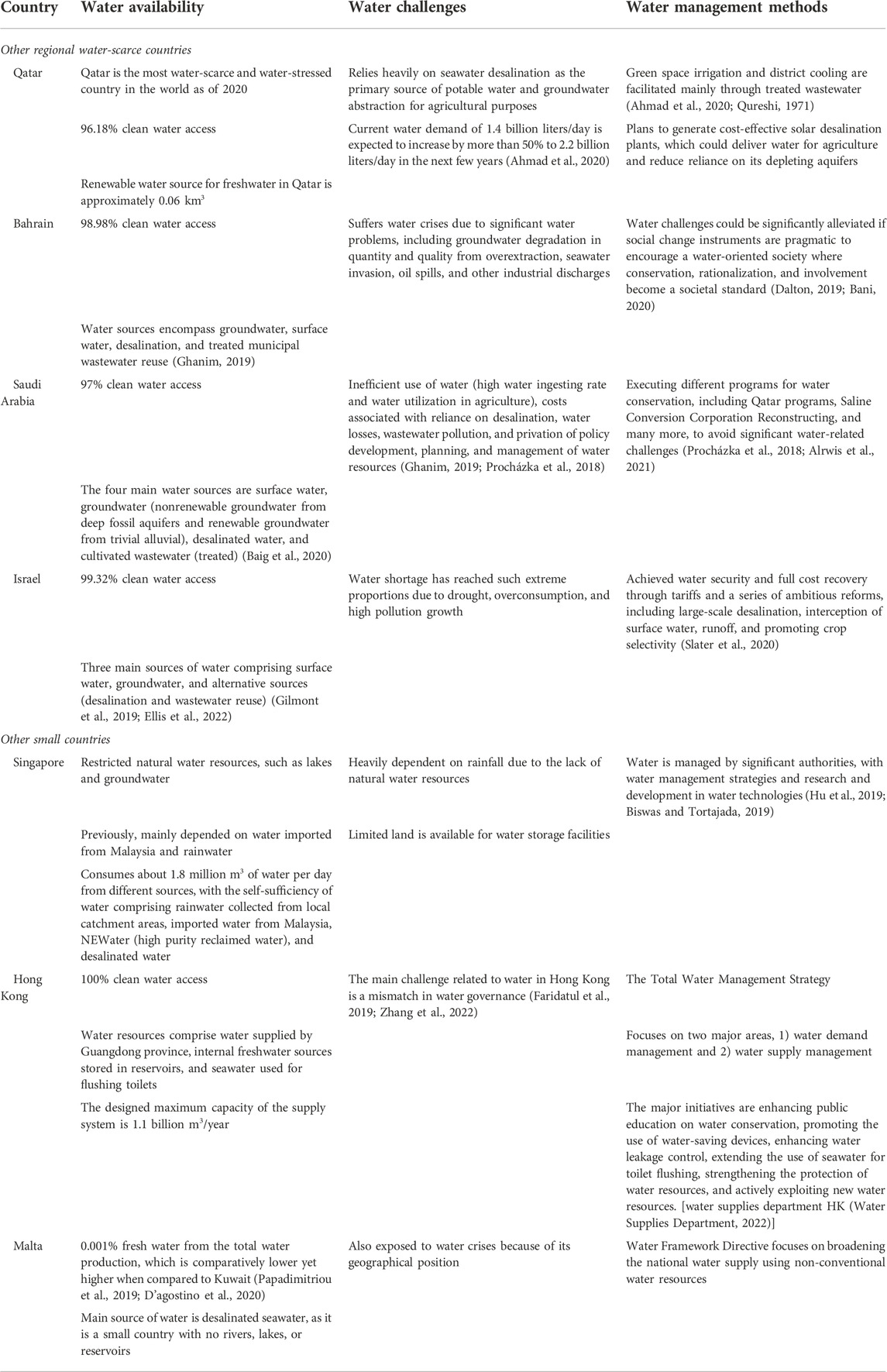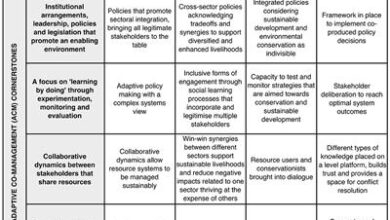A detailed perspective of water resource management in a dry and water scarce country: The case in Kuwait

1 Introduction
Kuwait is a developed country in western Asia, located on the northern side of the Arabian Gulf with a latitude and longitude of 29° 30′ N and 45° 45′ E, respectively, as shown in Figure 1. The country has an area of approximately 18,000 km2 consisting of sandy and gravel deserts and accommodates a population of 4.5 million residents (World Bank, 2022). The topography of Kuwait is typically flat, busted only by intermittent low hills and shallow depressions. Kuwait is an arid region where rainfall is scarce and inconsistent, with a mean of 115 mm/year and an extremely high probable evaporation of 2,608 mm/year (Al-Qallaf et al., 2020). As a result, the country’s potable water supply heavily relies on seawater conversion due to its arid climate, limited freshwater resources, and low annual rainfall. It is considered a water-scarce country (Viswanathan and Al-Senafy, 2020).
Kuwait has a severe water problem due to its location in an arid part of the Middle East and North Africa and the unavailability of readily available surface water. Only a low threshold of fresh groundwater exists in the north of Kuwait, where the water is brackish to salty. The country had just 4.8 m3/year/capita of renewable water resources in 2018. Kuwait’s renewable water resources per capita fell gradually from 17.3 m3/year in 1977 to 4.8 m3/year in 2018 (World Bank, 2022). Therefore, the country relies heavily on desalination plants to satisfy its freshwater demand. As a result, the desalinated water and the brackish groundwater extracted from the soil in Kuwait’s central and southwest areas are combined to produce irrigation water (Viswanathan and Al-Senafy, 2020), (Mukhopadhyay and Akber, 2018). Even with these current approaches, the demand for safe potable water is inclining, requiring a rapid growth of the country’s desalination capacity due to population growth and industrial and commercial developments (Mukhopadhyay and Akber, 2018), (Alfalah, 2021). Besides, the per capita water utilization has, for the most part, tended to extend instead of decrease. However, this may be considered a work of life fashion and populace thickness (Alfalah, 2021), (Alsulaili et al., 2022). Additionally, brackish water wells are in danger due to the absence of natural replenishment. Hence, the challenge for Kuwait at present is to utilize the existing scarce water resources optimally to satisfy the demand (Akber and Mukhopadhyay, 2021), (Aleisa and Alshayji, 2019). The existing water resources in Kuwait are presented in Table 1 with their respective contributions.
Kuwait is among the 10 poorest countries in terms of water resources per capita. In contrast, its water consumption is among the highest in the world, with per capita consumption averaging at 447 L/day (World Bank, 2022). According to Darwish and Al Awadhi (2009), the good extraction in Kuwait is about 307 m3/year/capita, whereas only 63 m3/year/capita is recycled to be used as potable water. This groundwater altogether supplies 92% of domestic and industrial water demand and accounts for 60% of the total water supply in the country (Prajapati et al., 2022).
Figure 2 represents the annual gross production and consumption of freshwater from 2010 to 2020 (World Bank, 2022). Accordingly, it can be observed that the gross water consumption is slightly more than the gross water production of the country, signaling that in the future, Kuwait will need more robust and direct strategies to fulfill its water demand.
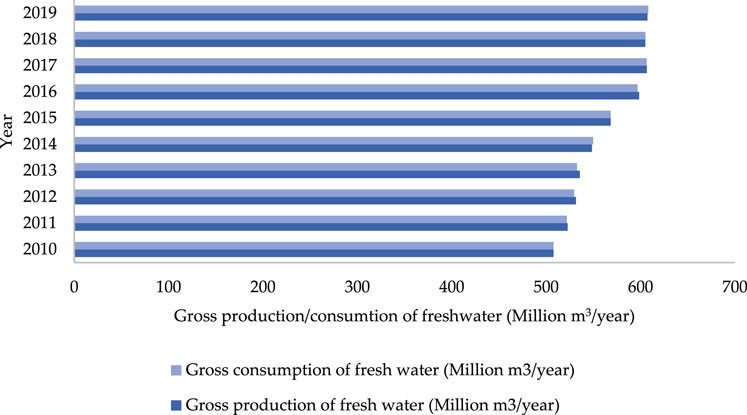
FIGURE 2. Gross production and consumption of freshwater in Kuwait (World Bank, 2022).
The natural resources of Kuwait have been extracted at significantly higher rates in the past (Aliewi et al., 2020; Al-Anzi et al., 2012) to satisfy the freshwater demand of the growing population. The annual population growth rate was observed at 1.35% in 2021, and the 25-year average population growth rate is estimated as 3.81% per annum (Aleisa and Alshayji, 2019). However, in recent years, efforts have been taken to reduce the extractions to conserve the limited available resources (Akber and Mukhopadhyay, 2021).
The region receives approximately 75% of its annual precipitation from November to February. Rainfall also varies with geographical locations. Rather than rivers and lakes, Wadis (an Arabic term that means the lower plain that is covered by mountains) are generated in the desert environment’s shallow depressions. Large depressions may experience surface runoff during the rainy season, which runs from November to April (Al-Qallaf et al., 2020). Flash floods may last from a few hours to a few days, but no permanent stream-gauging station records this information. Because of the significant evaporation losses and significantly lower soil moisture levels, only a tiny quantity of precipitation reaches the groundwater. The runoff ratio is also lower in this region (Aldosari et al., 2020). Therefore, rainfall is not a source of groundwater recharge in Kuwait, and water management has been a critical aspect of residents’ lives (Al-Qallaf et al., 2020; Mukhopadhyay and Akber, 2018).
People in Kuwait managed water in the past using infiltrated rainwater that was available in the narrow hand-dug wells. The former high-yield groundwater well was revealed in 1906. Until 1925, when dhow was used to ingress freshwater from Shatt Al-Arab, the primary potable water resource was the narrow artesian wells (Mukhopadhyay and Akber, 2018), (Al-Murad et al., 2018). Kuwait started importing freshwater from Iraq, which is roughly 100 km northwest. At the height of the oil boom in 1946, a daily flow of 0.30 m3 of water was conveyed from Shatt Al Arab (Al-Sulaimi et al., 1996). After rapid development in the 1950s, water shortage became a significant obstacle to economic expansion. This resulted in the development of alternative approaches to create non-traditional sources of water. Importing water from neighboring Iraq or Turkey, using groundwater, and desalinating salt water were the sole options for a while (Abdallah El Naka and Abdelrazek, 2022; Amery, 2012). Because the first option was not politically viable, the second was confined. However, when water was more widely utilized, the third approach was adopted (Viswanathan and Al-Senafy, 2020), (Aliewi et al., 2017).
Many techniques and strategies have been used to fulfill the demand for potable water in Kuwait, mainly incorporating seawater and brackish water desalination, recycling renovated wastewater, utilizing groundwater revitalization schemes, and instigating water conservation measures (Mukhopadhyay and Akber, 2018). Even with the established strategies to acquire potable water, evaluating and predicting water demand are necessary for successful water management. The projected freshwater demand in Kuwait in 2025 is in the range of 722–3,036 million m3/year, and to fulfill such a demand, the capacities of non-traditional water sources should increase exponentially (Alfalah, 2021; Ibrahim et al., 2020).
1.1 Existing studies on water resource management in Kuwait
Sufficient scientific literature is currently available on different aspects of Kuwait’s water resources and management. These studies cover a range of knowledge areas, including but not limited to water supply, water quality, water scarcity, water resources, water economy, water governance, and the desalination potential of Kuwait. This study reviewed the most recent publications (since 2015) to understand the present situation in the country. Mukhopadhyay and Akber (2018) reviewed the status of water demand and supply in Kuwait and identified that “at the current rate of increase in demand for freshwater, large investment is necessary at close intervals to augment the desalination capacity of the country.” Theyalso proposed correctional measures to overcome the recognized issues of water supply and management. Aljamal et al. (2020a) used an institutional analysis and development (IAD) framework to examine water resource-related issues in Kuwait and other arid Gulf countries. It exhibits how the implementation of alternative institutional arrangements could assist in addressing issues related to water. Ben Hassen and El Bilali (2022) investigated the governance and political economy of water in six states in the Gulf Cooperation Council (GCC), including Kuwait, and proposed water solutions and policies to overcome identified challenges. Aljamal et al. (2020b) investigated the reasons for public resistance to reducing water subsidies in Kuwait and demonstrated that the resistance primarily stems from perceptions about government responsibility, equality and equity, and poor awareness of environmental issues related to water. Aliewi et al. (2017) investigated the alternative management options and policies on water resources in Kuwait and described how to evaluate them on a strategic level that can lead to better and more sustainable future water resource management. When evaluated against a set of economic, social, and environmental parameters, desalination enabled by renewable energy technologies has been ranked highly despite its economic costs. Al-Rashed and Aliewi (2017) proposed a water resources sustainability plan for Kuwait, considering its social, economic, and environmental conditions to achieve UN sustainable development goals. Mabrok et al. (2022). developed an EPANET-based model to evaluate water quality in Kuwait. Aleisa et al. (2019) conducted a general review of treatment and reuse practices of domestic wastewater in Kuwait at present; discussed future plans, challenges, costs, and tariffs; and proposed recommendations for better utilization of treated effluent in the future.
Several studies have investigated the current strategies used for water resource management in Kuwait and identified the importance of taking proactive measures to conserve and better manage the limited and scarce water resources. Therefore, the following section demonstrates the aim and objectives of this study and the methods used.
1.2 Research aim, objectives, and methods
Kuwait has one of the highest water consumption per capita in the world, with 165 m3/capita/year. Many research studies have investigated the significance of water resource management in Kuwait, as discussed in the previous section, and emphasized the necessity and urgency of developing more effective and efficient water management strategies. Despite conducting many studies on this specific research area, it is imperative to conduct further research to evaluate the status of water resources and management to better understand the issues, inefficiencies, and problems associated. Therefore, this study covers various aspects of water resources and management along with a literature review of existing studies to evaluate the current status. It aims to investigate the water resource management in Kuwait, and the objectives are formulated as follows: 1) to identify primary freshwater resources, 2) to assess water consumption and management systems, 3) to evaluate the water economy, 4) to review governance framework, and finally, 5) to compare with countries with similar conditions. The study follows a review of existing published data as a research method to achieve the established objectives.
The following sections present the review of each aspect listed under research objectives.
2 Primary water resources and management
The main water resource management in Kuwait is instigated by analyzing the primary water resources, water consumption areas, and effective techniques and processes utilized to acquire non-traditional water sources.
2.1 Main sources
The total renewable water resources in Kuwait as of 2021 is stated as 0 billion m3/year, making water dependency 100% (World Bank, 2022). Hence, the main water sources in Kuwait can be listed as 1) desalination of seawater, 2) brackish groundwater, and 3) treated wastewater. The following sections describe in detail each different source.
2.1.1 Desalination of seawater
For the last 33 years, Kuwait has been fully dependent for its potable water resource on the seawater desalination plants using steam boiler turbine generators (SBTG) and multi-stage flash (MSF) saltwater desalination systems. The desalination technologies mainly comprise MSF, multi-effect distillation (MED), vapor compression distillation (VCD), electrodialysis, and reverse osmosis (RO) (Mukhopadhyay and Akber, 2018; Akber and Mukhopadhyay, 2021; Amery, 2012). By utilizing the process of MSF distillation, approximately 90% of potable water demand is fulfilled (Aljuwaisseri et al., 2022a; Feria-Díaz et al., 2021). The initial desalination water plant was installed in 1951, which was replaced in 1960 by the primary MSF desalination plant with a mounted capacity of 4,546 m3/day, providing 92% of water for domestic and industrial requirements and about 60% of total water resource in the country (Mukhopadhyay and Akber, 2018; Feria-Díaz et al., 2021). Eight desalination plants in Kuwait are positioned beside the coast, with a total mounted capacity of 3.11 million m3/day (World Bank, 2022). Table 2 and Figure 4 represent the details of these plants.
As a result of the effective desalination plants, there has not been enough effort made to put in place policies that encourage conservation and limit the exploitation of natural resources, nor are there any prudent decisions by the authorities. However, it is becoming harder to ignore global climate change and pollution due to excessive anthropogenic emissions (Aljuwaisseri et al., 2022b; Al-Shayji and Aleisa, 2018). The Ministry of Electricity and Water (MEW) has already started upgrading its technical infrastructure for the transmission of power and water. Since 2005, large-scale power-generating facilities have relied on open and closed-cycle gas turbines. Currently, a seawater RO plant is under construction, facilitating more efficient water management. Future mega-capacity power and water desalination plants that use more contemporary and efficient technology to reduce carbon emissions are continually emerging (Ahmed et al., 2020).
However, MEW’s public campaign to promote and stimulate energy and water conservation has taken place over the last few years to establish an environment where consumers may work together to save money and resources. To combat the detrimental consequences of the present situation, MEW must modernize and better use its existing power and water desalination facilities. The MEW and the Kuwait Institute for Scientific Research (KISR) have begun a joint investigation on the country’s present power generation and desalination infrastructure. This review focuses on reliability and efficiency, identifying future operational and economic improvements and rating them appropriately (Aliewi et al., 2017; Hindelang, 2021). They looked at SBTG and MSF facilities for their specificity in the investigation.
Many issues plague desalination plants, the most serious of which is the use of unsuitable fuel, which causes considerable damage to different plant components and, consequently, reduces the plant’s ability to generate electricity. Another issue is that the MSF plant’s maximum operating temperature and production capacity are limited due to poor weld quality and low-grade materials used in construction. A third issue is that an incorrect water intake design and location leads to sedimentation, erosion, and excessive use of chemicals (Hassan et al., 2019; Alomirah et al., 2020; Zhang and Liu, 2021).
Total production expenses are higher than usual because of the high fuel cost. Equipment that is outdated or worn out needs to be replaced more frequently. Knowing which plants demand the most attention and which require the least is important. Corrosion is taking its toll on the MSF facility, which is suffering the consequences of its age. A well-maintained MSF might stay in use for an extended period without needing costly repairs if it is regularly maintained. Flue gas ducts and other components are damaged and corroded by high Sulphur content in certain plants’ heavy fuel oil (Kotwicki et al., 2014; Abdel-Basset et al., 2019). The cost of desalinated water is USD 1.04, USD 0.95, and USD 0.82 for MSF, MED, and RO, respectively, assuming a fuel cost of USD 1.50/GJ (Ahmed et al., 2020). The most common technology used in desalination plants is the MSF; therefore, many studies and analyses have focused on that technology, as discussed above.
2.1.2 Brackish groundwater
Brackish water occurs in a natural environment with more salinity than freshwater but not as much as seawater. Brackish groundwater is groundwater with a total dissolved solids content of 1,000–10,000 parts per million (Water and Board, 2017). One of the main natural sources of water available in Kuwait is the brackish groundwater located in Sulaibiya, Shigaya, and Umm Gudair fields. The rest of the groundwater is mainly saline.
Brackish underground water is extracted using a regional system consisting of two aquifers: the Kuwait group and the Dammam Formation. The Kuwait group is the upper aquifer composed of layers of sediment and clastic rocks saturated with water. The total dissolved salts (TDS) in this aquifer are approximately 4,000–9,000 particles per million. The lower aquifer, referred to as the Dammam Formation, contains layers of consolidated limestone and groundwater moving continuously with the slope direction. TDS in this aquifer is 3,000–6,000 particles per million in the south and west of Kuwait (Aliewi et al., 2020; Al-Murad et al., 2018).
Over the years, prolonged groundwater abstraction, which exceeded the renewable volume, caused the depletion of aquifer storage and resulted in a decline in groundwater levels and an increase in the water’s salinity. The groundwater abstraction during 1900–2020 is shown in Figure 3.
Currently, the total output of groundwater wells is around 0.55 million m3/day, whereas the maximum daily consumption in summer could reach up to 0.23 million m3. Approximately 10%–13% of Kuwait’s total groundwater production is blended with desalinated distilled water to make it potable. Groundwater is used for various purposes in Kuwait, including irrigation, gardening, construction, and even animal watering (Al-Murad et al., 2017). Currently, this water system satisfies the demand for water for more than 75,000 consumers at a considerably lower price. Other proposals are being evaluated to set up production facilities through new fields in the Northwest and the Northeast.
2.1.3 Wastewater recycling
Water recycling is considered a crucial non-conventional water source in Kuwait due to the high cost of seawater desalination. According to Aleisa and Alshayji (2019), the wastewater generation in Kuwait is 154.6 m3/capita/year. Approximately 75% of this wastewater is treated, and 58% becomes available for reuse (77% treatment efficiency). Municipal wastewater in Kuwait is treated at four treatment plants in Jahra, Riqqa, Sulaibiya, and Umm Al Hayman by utilizing distinctive techniques, including ultrafiltration, sand filtration, and chlorination (Abusam and Shahalam, 2013). Details of the four plants are presented in Table 3, and their locations are shown in Figure 4.
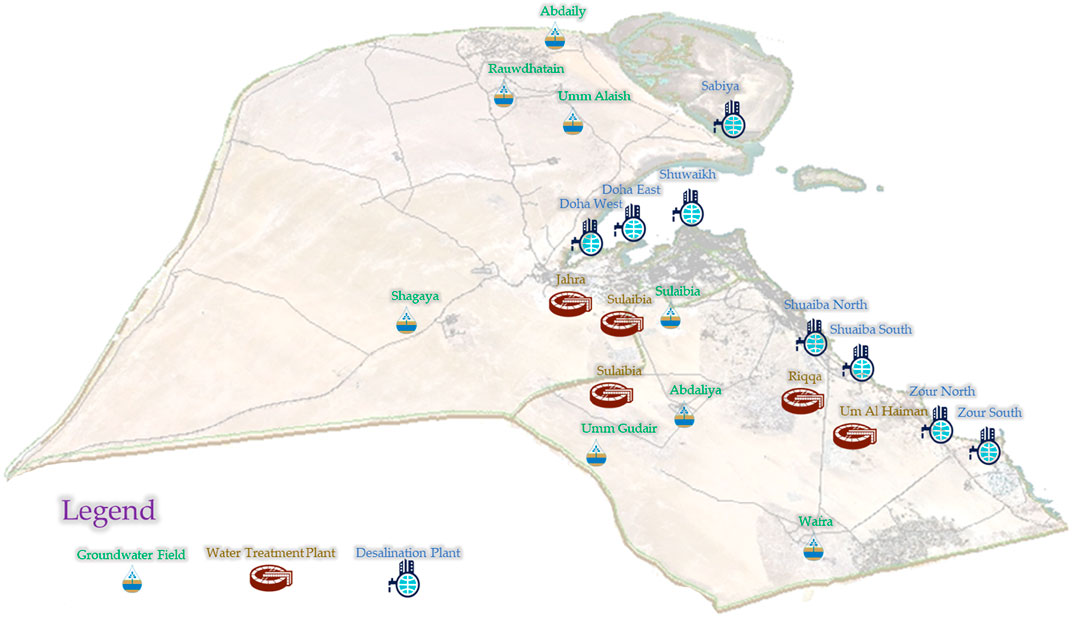
FIGURE 4. Locations of groundwater fields, water treatment plants, and desalination plants in Kuwait.
Among the four plants, the Sulaibiya water treatment plant is the only one that produces potable water according to WHO Standards (Cotruvo and Marcus, 2017), and its capacity is approximately 600,000 m3/day (Water Technology, 2022). Wastewater treatment plants in Umm Al Hayman started operation in 2001 with an initial capacity of 500,000 m3/day and have been increasing their capacity throughout the years, reaching an ultimate of 700,000 m3/day. All these treatment plants are improved to increase their capacity by establishing and enforcing legislative frameworks and government aid.
Most people in Kuwait are aware of the importance of reusing treated wastewater. Recycled water is more affordable than desalinated water in Kuwait. It costs around $0.78 to produce a thousand liters of recycled water, whereas it costs around $3.13 for desalinated water (Darwish et al., 2011; Jasem and Madzikanda, 2012; Ali et al., 2015). Regardless, most people of Kuwait (77.91%) disapprove of the use of treated wastewater for drinking water. Citizens of Kuwait have various reasons for their disapproval, such as health reasons (69%), psychological reasons (54%), and religious beliefs (29%). They do not trust the workmanship at the plant (25%), fear mechanical breakdowns (19%), and reject it for other reasons (7%). Reclaimed water is a vital resource that can be used in the agriculture and industrial sectors, and 75.28% of Kuwait agrees (Jasem and Madzikanda, 2012). Several studies have examined the link between the socio-demographic characteristics of individuals and recycled water (Marks et al., 2006; Menegaki et al., 2007; Dolnicar et al., 2011; Ansorge and Dlabal, 2017). The most common factor that has been identified as related to the level of acceptance of recycled water is the education level of the individuals. Other factors such as age, gender, and income also have been linked to the acceptance of recycled water. Based on the findings of these studies, Dolnicar and Schäfer (2006) proposed the introduction of high-status recycled water in the market. They suggested that the introduction of high-status recycled water should be carried out through a behavioral modification approach. Po et al. (2007) stated that effective methods to assure public acceptance include community involvement, accurate information policies, and empowerment of the people (Po et al., 2007).
2.2 Water demand and consumption
There are typically three main sectors that heavily rely on water resources, including 1) the municipal sector, 2) the agricultural industry, and 3) the industrial or economic sector. Kuwait’s water consumption is among the highest in the world, with per capita consumption averaging 447 L per day (Almottiri and Wegian, 2021; Alsumaiei, 2021). Approximately 44% of the total water produced is utilized for municipal purposes, whereas 54% and 2% are allocated for agriculture and industrial purposes, respectively (World Bank, 2022). Potable water quality is controlled by managing the blending ratio between the distilled water and brackish groundwater (Shafiullah and Al-Ruwaih, 2020).
The agricultural areas are in three significant directions and have approximately 2,880 farms with 141 million m2. However, 90% of Kuwait’s land is considered unsuitable for agricultural purposes, where main crop productions include vegetables, potatoes, and grains (Al-Murad et al., 2017). There are three main sources of water in Kuwait for agricultural utilization: brackish groundwater, treated wastewater, and desalinated water. Approximately 54% of groundwater and 19% of treated wastewater are used for agricultural sector applications (Aleisa and Alshayji, 2019). Kuwait’s agricultural sector experiences a small role in the nation’s economy due to extremely high temperatures during the summer season and poor quality of groundwater (Al-Murad et al., 2018; Al-Murad et al., 2017). Water is crucial in agriculture for the production and maintenance of food security. However, the crop water efficiency in Kuwait is highly affected by the lack of a proper drainage system, the calcareous nature of the soil, and high evaporation rates from the soil surface (Al-Menaie et al., 2021).
Power/energy generation and food are the main industries dependent on water. Apart from water, food, and energy, sustainability is also crucial for the development of any country. Kuwait is highly prone to food insecurity. According to the global food security index (Hameed et al., 2019; Abbas et al., 2020), Kuwait is ranked 30th. Food security using food supply in Kuwait can be maintained by developing and improving the agriculture sector, farming practices, crop selection, dominating aquaculture in terms of giving importance to seafood as a component of the food supply mix, and food import strategy (Siderius et al., 2019). In short, water security, food security, and energy security are linked together, known as the water energy and food security nexus, which is also observed in other countries (Hameed et al., 2019; Siderius et al., 2019).
The average cost of food products imported into Kuwait in 2019 is almost $2 billion, and its import product share is about 6% of total import products. AHS weighted average, which is the effectively applied weighted average percentage tariff (tax), is about 32%. It is the average of tariffs (tax on exported things) weighted by their corresponding trade value (World Bank, 2022). The average cost of food products exported is about USD 278 million, and the volume of exported product share of food products out of all other exported products is 0.4%. The food products that Kuwait export include meat and edible meat offal, tobacco, animal and vegetable oils and fats, oil seeds, oil nuts, and oil kernels, and imported food products mainly comprised of edible fruits, nuts, peel of citrus fruit, cereal, flour, starch, and milk products.
2.3 Water management systems
Water resource management incorporates the actions of preparing, emerging, allocating, and managing the finest use of water resources. For sustainable development and water use in agriculture, renewable technologies are ranked higher owing to positive economic and environmental effects (Viswanathan and Al-Senafy, 2020; Mukhopadhyay and Akber, 2018). The main techniques and processes of water management in Kuwait incorporate rainwater drainage and water supply systems, which are explained in the following sections.
2.3.1 Rainwater drainage system
In the past, Kuwait mainly depended on rainwater, and the rainfall season typically starts in October and ends in May. The minimum rainfall recorded in Kuwait was 30 mm in 1960 (Zaghloul and Al-Mutairi, 2010). The rainwater or stormwater runoff is gathered in open inlets from streets and open areas, and the surface runoff is routed through pipes and box culverts to various outfall locations on the gulf. One of the rainwater/stormwater drainage systems is located in the south Al-Doha area, 26 km west of the city, typically comprised of circular concrete pipes using which water flows exclusively by gravity to the outlet (Al-Hurban et al., 2021; Chkhvimiani et al., 2021). Due to the exceptionally low rainfall and very high evaporation rates, the runoff occasionally happens as a result of rare heavy rains. The retention of this water is not economically viable. Figure 5 represents the data and the graph showing the annual rainfall in Kuwait from 2005 to 2020.
2.3.2 Water supply network
The water supply in Kuwait mainly consists of two water supply networks: freshwater and brackish water (Mabrok et al., 2022; Alhumoud and Almashan, 2020). Each network comprises underground reservoirs, pumping stations, and pre-eminent towers. The brackish water is utilized for irrigation and agricultural land, public parks, and domestic use, whereas freshwater is produced from desalination plants pumped to underground reservoirs and distribution networks (Statistical Yearbook Water In Kuwait, 2019). The network or number of connections to significant buildings, mainly comprising private, commercial, and industrial buildings, was about 185,151 for freshwater and 76,488 for brackish water, and the distribution rate of these stations is in the range of 10%–12% of the general consumption. Figure 6 represents the schematic diagram of Kuwait’s typical residential water supply network (AlMayyas and Leeb, 2015).
2.3.3 Possible conventional solutions
Due to the lack of natural sources to fully satisfy the water demands, some indigenous solutions and steps are required to overcome the challenges of water management as follows (Viswanathan and Al-Senafy, 2020; Al-Otaibi and Mukhopadhyay, 2005):
1) Decreasing subsidies to reduce water traffic.
2) Controlling immigration which occurs due to the economic attraction of foreigners.
3) Using reclaimed wastewater for gardening and non-potable needs.
4) Utilizing the water produced by dewatering wells to reduce groundwater usage.
5) Artificial recharge of the aquifer for vindicating the variability in water demand and water accessibility.
6) Allowing sharing of water linkage between Gulf Cooperation Council (GCC) countries.
7) Executing conservational measures to defend the available water resources from environmental dilapidation.
8) Minimizing the loss of water from pipe leakage through significant maintenance of the water network.
9) Undertaking institutional measures to overcome the ambiguity related to water resource management.
2.3.4 Modern technology-based solutions
The implementation of other new techniques apart from RO for the improvement mainly incorporates the applicability of the Soil Aquifer Treatment (SAT) technique in the renovation of wastewater and nano-filtration as a preprocessing method that makes the high-temperature MSF distillation possible, resulting in higher production of water (Ahmed et al., 2020; Zhang and Liu, 2021).
In addition to the utilization of MSF for desalination, a new technique for desalination is also now undertaken as an alternative due to the inefficiency, high cost, and energy requirement of the existing systems. The new system or technique is referred to as the SWRO system, which saves up to 75% of the fuel energy used for desalination (Darwish and Al Awadhi, 2009; Ahmed et al., 2020). The advanced renovation technique for municipal wastewater treatment as an alternative to RO developed water with high quality and lower cost, saving approximately 50% of the distillate cost generated by MSF plants. This treatment technology has been integrated into a reclamation plant in Sulaibiya to generate high-quality water (Al-Shayji and Aleisa, 2018; Darwish et al., 2011).
Another advanced technique for the sustainable management of water resources is the remote sensing technology for estimating the recharge potential and precipitation of shallow freshwater aquifers (Ud Din et al., 2007).
3 Water economy
Kuwait has a mixed economic system, and due to the scarcity of water, it is considered a valuable commodity and mainly utilized for agriculture, industry, and households. Water consumption in different sectors in Kuwait is shown in Figure 7. The cost of water is small compared to the average household income. Kuwait’s economy is heavily dependent on oil export revenues, and the requirements and demands for fossil fuels by CPDPs [co-generation power desalting plants (CPDP)] to generate power and desalt seawater is growing annually (Alhajeri et al., 2018).
3.1 Direct costs of domestic uses
Global statistics (Saleh, 2022) show potable water consumption from 2005 to 2020 and indicate that the net consumption volume of potable water in Kuwait is approximately 589 billion liters, as represented in Figure 8.
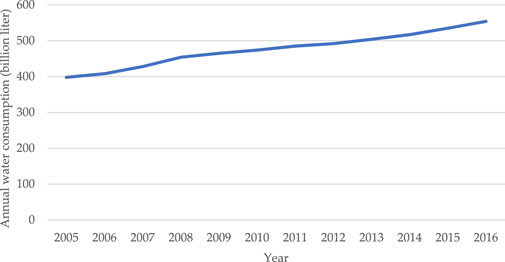
FIGURE 8. Potable water consumption in Kuwait in billion liters per year (World Bank, 2022).
The total freshwater consumption for households and the residential sector has increased from 150 billion liters in 2001 to 634 billion liters in 2020 (Alsumaiei, 2021). To produce 1 m3 of water, the ministry of energy costs USD 2.42, but the customer is charged USD 2.72. According to water Action Hub, the annual cost of water for sanitation is 28% of the total annual estimated cost, accounting for $96,985,552 and the cost for industrial pollution and agricultural pollution is $16,711,435 and $2,145 (Al-Ballam et al., 2018; Al-Fadhli et al., 2020). According to the KISR, the current cost of providing a reliable source of fresh water in Kuwait (principally through desalination plants) exceeds USD 1.2 billion annually (Alhajeri et al., 2018).
3.2 Indirect costs of water
This section represents the details of Kuwait’s expenditure on food per capita that represent the indirect cost of water impact on food. Water consumption and water importance have to be explained in all fields. It has been stated that Kuwait’s expenditure on food per capita was at a level of $1,910 in 2018, up from $1,841 the previous year, a change of 3.76%, and the percentage change of expenditure on food is about 19.22% (World Bank, 2022).
Figure 9 represents the data and the graph showing the cost of food from 2010 to 2020 in Kuwait.
3.3 Water subsidies
Subsidies are financial assistance given by the government to reach a specific policy goal, such as water security, generally used for promoting water efficiency by households, farmers, and companies. Kuwait subsidizes about 92% of production costs, making water prices among the lowest in the world, but Kuwait has one of the highest per capita consumption rates (Ibrahim et al., 2020; Almottiri and Wegian, 2021). Water and sanitation can consume a significant amount of a country’s scarce public resources because these subsidies cover operations expenditures, mainly staffing costs, maintaining existing structures, and infrastructure rehabilitation (World Bank, 2022).
4 Challenges and issues of water
Some countries face serious challenges in securing their water resources, which are diminishing due to droughts, low rainfall, and ubiquitous climate. Mostly these countries are gulf countries, including Kuwait. These challenges comprise increasing water demand, falling per capita water availability, high dependency on desalination, inefficient water use and water leakage in supply networks, exploitation of groundwater aquifers, limited water treatment capacities, greater water subsidies, and ineffective legislative frameworks (Aleisa and Alshayji, 2019; Amery, 2012). Kuwait’s water security issues can be controlled by taking some actions, mainly comprising reducing water subsidies, reusing treated wastewater on a large scale, investigating and exploring new non-conventional water resources, enforcing measures to converse and protect water and reducing the political water issues, and reducing network loss (Zúñiga-Estrada et al., 2022), (Alazmi, 2022).
Water has always been considered of political importance, particularly in arid regions of the world. Kuwait is also considered an arid country and scarce in water, and its water scarcity leads to political or violent conflict or hydro politics (Aljamal et al., 2022). This is mainly due to a lack of action to ensure sustainable, equitable water access. By undertaking hydro politics, Kuwaiti authorities are affected by the historical narrative and context of their relationship with Iran, as Kuwait imported water from Iran in the past, leading to potential instability and conflicts (Aljamal et al., 2020b; Loftus et al., 2019). Kuwait took actions beyond its national boundaries to boost its water resources. In 2001, the government improved the water tariff. Water is a highly charged political resource, and the process of political and socio-cultural needs to lead the techno-engineering struggles that gradually construct an atmosphere of regional reliance and cooperation (Aljamal et al., 2022; Loftus et al., 2019).
5 Water governance framework
Water management or governance in Kuwait is liable for the strategy and assessment of farm irrigation systems, analysis of irrigation equipment, exploration of crop water, observation of groundwater prominence and capacity, and water resources planning. To manage water availability and water demand in Kuwait, MEW was established in 1952. In 1964, water management implemented a certain policy and an 11-article-based law related to the prohibition of polluted water areas and inland waters, also known as Law No. 12/1964. During 1995–1996, the main concern of the water management authorities was monitoring water quality, environmental balance, and biodiversity protection. In 2019, specific policies and techniques were enforced targeting protecting marine life. Apart from these strategies, the establishment of the KISR in 1967 and KISR’s Water Research Centre (WRC) in 1973 demonstrated significant multidisciplinary methods to discourse Kuwait’s defies in water resources management and cultivated pioneering desalination technologies (Aljamal et al., 2020b; Hameed et al., 2019; Aliewi and Al-Rashed, 2022). Water resource management in Kuwait can typically be divided into three components: 1) institutional setup, 2) legal framework, and 3) water resource development. The flowchart representing the three components with their sub-categories is shown in Figure 10.
5.1 Institutional setup
The institutional setup in Kuwait related to the water policies can be designed and managed by following significant steps. The steps involved in designing and managing the institutional framework include collection and storage of all data, intermittent analysis, and examination of these data and information by the water authorities of the country, an adjustment in the water management policy, motivating the public for the implementation of water conservation measures through media campaigns and other related techniques (Abbas et al., 2020; Lambert, 2013).
The critical government and non-key government organizations handle food and water issues. These organizations mainly comprise several ministries and authorities with varying responsibilities as follows:
1) MEW: responsible for securing water demand, rationalizing water consumption, achieving water security, and desalination services.
2) Ministry of Public Works (MPW): responsible for supervising infrastructure developments and maintenance works of pumping.
3) Kuwait Environmental Public Authority (KEPA): a public authority responsible for developing strategies and action plans to protect the environment.
4) Public Authority for Agricultural Affairs and Fish Resources (PAAFR): responsible for the design and evaluation of farm irrigation systems, crop water requirements, and monitoring groundwater quality and quantity.
5) KISR: responsible for the development of strategies and desalination techniques.
Table 4 elaborates the roles and responsibilities of the institutional setup.
5.2 Legal framework
Water resource policy involving the ocean includes jurisdiction and regulation issues, pollution regulation and reduction, overexploitation prevention, and desalination to make potable water. The main water policies and regulations in marine are related to the prohibition of polluting marine areas and inland waters, industrial wastewater transportation, environmental protection related to land, water, and air from pollution, and the execution of a national plan for the marine environment management (You et al., 2021).
The frameworks with a brief description of the main and significant policies and laws, decrees, and resolutions related to water are described in Table 5.
5.3 Water resource development
Water resource development mainly incorporates the multi-phase progression that initiates from the commencement of certain water supply projects, irrigation, or basin master plans. Water resource development in Kuwait is demonstrated by KISR, which commenced the Water Resource Development and Management (WRDM) program to recognize means to sustainably augment the use and control of the country’s water resources through pragmatic research. The WRDM program was also intended to maximize water security in Kuwait. This program incorporated tactical water policies, management preferences, and action plans to assuage water problems and maximize socioeconomic progression. These progressions mainly comprise the following:
• Monitoring water quality since 1995.
• Assessing hydrocarbon pollution of fresh groundwater resources in Kuwait.
• Assessing the urbanization on groundwater levels and quality in Kuwait by minimizing the impact of the rising water table.
• Designing groundwater utilization schemes for the Northern Oilfields of Kuwait by sustainably increasing water production (KISR, 1995).
The main ongoing projects of WRDM encompass assessing artificial aquifer rejuvenation using RO-treated wastewater by actively replenishing the Dammam formation, Domestic Water Consumption and Conservation in Kuwait by identifying consumption patterns, surveying and desert subsurface aquifers using radar technology, and utilizing the hi-tech approach to precarious problems (Abbas et al., 2020; Aliewi and Alomirah, 2020). Another project related to the supply of potable water in Kuwait includes the Shuwaikh RO project. The main purpose of this project was to provide a sustainable water supply, which has been a major concern and issue for many countries in this region. Sanitation is one of the issues related to water management in Kuwait, and the Kuwaiti Ministry of Public Works has proclaimed strategies to commence new sanitation projects in the country at the cost of USD 306 million, containing building sewage treatment plants, mains, and pumping stations.
Table 6 demonstrates the growth in the production and consumption of fresh water in Kuwait during 1999–2019. According to the data, an upsurge in gross water production and consumption has been shown. However, per capita consumption has been declining over the years with a change of approximately −9%.
According to Ibrahim et al. (2020), the demand for freshwater in 2025 is predicted to be between 722 million m3/year and 3,036 million m3/year. After 2000, an additional 1.2 million m3/d to 9.1 million m3/d of desalination plant capacity had been accessible. According to statistics until 2019, the desalination capacity had grown and upsurged to the value of 2.4 million m3/day. Desalination capacity might be increased further if the country’s population and economy continue to grow at present. Until recently, no thorough study has been done on Kuwait’s rising brackish water usage and its expected future development. Using treated municipal wastewater for irrigation has reduced the productivity of brackish water farms since 2006 (Abusam and Shahalam, 2013).
6 Comparison with countries of similar conditions
Kuwait is a country of the Arabian Peninsula located in Western Asia with an area of 17,820 km2. Natural water resources are erratic in this region, combined with negligible precipitation and great evaporation amounts. These are just some of the causes of dwindling water resources at alarming stages in this region. Groundwater is the primary source of freshwater in Bahrain, Kuwait, Qatar, and Saudi Arabia. At the same time, surface water is the dominant source of freshwater in Oman and the United Arab Emirates (UAE) (Al-Farra, 2015). Concerning the economic aspect, Kuwait is ranked seventh amongst the 14 countries in the Middle East and North Africa region. The economic freedom score is 6.73, above the regional average but below the world average (6.14).
Even with a performing economy, Kuwait is confronting many challenges regarding water resources management. A regional comparison is presented in Table 7, identifying the strengths and challenges of countries with similar climate conditions and geographical positioning.
Kuwait faces water shortages because of the absence of natural water resources, poorly developed supply infrastructure, and the practice of expanding irrigated agriculture and industrialization (Aliewi et al., 2017). As per the regional comparison, Kuwait is located between Qatar and Israel, with a middle level of water availability and accessibility. When reviewing countries at risk due to water scarcity, Kuwait is ranked seventh, and Qatar is ranked first, followed by Israel and Lebanon in second and third places, respectively.
The main challenge related to water in Hong Kong is a mismatch in water governance. However, in Kuwait, the main challenge is the lack of water resources and higher demand (Faridatul et al., 2019; Zhang et al., 2022). Apart from the economy and area comparison, in terms of water sources, Kuwait has a negligible percentage of water, whereas Hong Kong comprises a high percentage of water than Singapore, Kuwait, and Malta.
7 Conclusion and recommendations
The substantial reasons for water scarcity and the water crisis in Kuwait incorporate the lack of freshwater resources, further worsened by increased water demands. Kuwait has been able to meet the freshwater requirements by adopting large-scale seawater desalination. Opting for desalination as the first choice is supported due to the availability of oils and direct access to Gulf waters. However, using electricity and water in this manner is not only wasteful but also environmentally irresponsible, particularly with the use of extensive amounts of fossil fuel-based oils.
The largest consumer of freshwater resources is the domestic sector (55%), followed by the agricultural (43%) and then industrial (2%) sectors (Abdullah et al., 2021; Darwish and Darwish, 2008). Kuwait is among the highest water consumer in the world despite depending on desalination plants (Alhumoud, 2008). On that account, in addition to significant projects and novel methods to increase water consumption, soft measures could be placed to ensure efficient water consumption, especially in domestic water consumption. One of the most important factors that can be considered in Kuwait is the implementation of education programs and public awareness. These programs can help the public and private sectors develop effective reuse strategies. Besides providing useful information, these programs can also help the consuming households. In households with water-efficient appliances, installing these can reduce indoor water consumption by up to 50%. For instance, replacing old toilets could save up to 50% of household water consumption (Muthukumaran et al., 2011). According to studies, the low elasticity of water pricing for indoor use is a major factor that contributes to the high consumption of water (Zapana-Churata et al., 2022). This suggests that a large price increase is required to reduce water consumption (Liu et al., 2003). Demand-side management (DSM) is designed to reduce water consumption and can be expected to achieve a 10%–20% reduction over a decade. The results of the studies suggest that although various programs can achieve moderate to slightly moderate reductions in water consumption, they are likely to require more stringent policies to achieve a larger reduction. For instance, implementing a price increase of more than 15% is required to achieve a significant reduction in demand (Inman and Jeffrey, 2007; Strbac, 2008; Warren, 2014).
Kuwait has successfully developed desalination, treated wastewater, and water accessibility and reduced groundwater abstraction. However, it remains insufficient to feed the present and future requirements because the continuous withdrawal of brackish groundwater is putting excessive stress on the aquifers. Water demand is rising rapidly along with increasing population pressure and a rise in the standard of living.
Kuwait has a mixed economy where water is considered a valuable commodity consumed in different domestic, agricultural, and industrial sectors. The water economy in Kuwait can be predicted by undertaking the direct estimated cost of drinking water, cost of water for other urban uses, costs for food, institutional setup to manage the water availability by policies and programs executed by different organizations, water subsidies, and water security with particular challenges and political importance of water due to scarcity.
The water governance framework in Kuwait mainly monitors the water quality, environmental balance incorporating the water resource development, legal framework including significant laws, decrees, resolutions, and institutional setup with the governmental and non-governmental organizations including MEW, MPW, KEPA, PAAFR, and KISR.
Water policies are currently slanted toward supply-side management and overlook the potential for water conservation, institutional setup, and organized implementation of various modern techniques to improve water quality and availability. However, for future requirements, significant actions are necessary to be taken as current institutional arrangements of the water sector are split, which leads to the supremacy of sub-sectoral water management approaches and obstructs cohesive management of the water sector. The corresponding planning between the water sector and other related sectors, particularly agriculture and energy, is informal and limited. Moreover, much legislation is outdated or missing.
Compared to other regional, small, and advanced countries, water resource management in Kuwait has peculiar characteristics. Kuwait is ranked in the seventh position among the most water-stressed countries. The country consumes a higher quantity of water per capita compared to other countries. Different strategies have been applied to different aquifers for obtaining groundwater to meet the water demand, including remote sensing techniques in the Raudatain basin in Kuwait. To meet future needs, substantial investment in expanding the desalination capacity will be necessary as Kuwait mainly depends on desalination. Other regional countries have also shown remarkable improvement by implementing different strategies and improving their water source techniques. These mainly encompass acknowledging water balance, water surplus, and water deficit; managing water demands by utilizing modern irrigation technologies; and using saline water for irrigation where possible. Mounting strains of crops that require less water and modifying crop mix, redistributing water supplies among other sectors and vindicating water consumption, and promoting water awareness are also effective strategies practiced in these countries.
The water cost is small compared to the average household income, and Kuwait’s economy heavily depends on oil export revenues. The requirements and demands for fossil fuels by CPDPs to generate power and desalt seawater is growing annually. Kuwait is one of the water-stressed countries due to its high dependency on desalination, inefficient water use and consumption, water network leakage, exploitation of groundwater aquifers, limited wastewater recycling, and missing or outdated legislation.
Water consumption can be controlled using a reduction in water subsidy, immigration control, use of reclaimed wastewater, use of water produced by dewatering wells, artificial recharge of aquifers, conservation measures, and reduction of network loss. Water management is crucial for any country, especially Kuwait, to utilize advanced techniques for long-term sustainable development.
To meet future needs, significant investment to increase the desalination capability will be crucial with undertaking significant actions comprising of exploring and emerging non-conventional water resources, implementing pioneering technologies for water and wastewater treatment, extenuating and controlling the pollution of accessible water resources, plummeting water network losses, and espousing new technologies for the creation and treatment of water can boost water security and protect the country’s valuable water resources.
Author contributions
Revising the manuscript critically for important intellectual content: MT, KW, RA and ZR. Approval of the version of the manuscript to be published: MT, RA, KW and ZR.
Conflict of interest
The authors declare that the research was conducted in the absence of any commercial or financial relationships that could be construed as a potential conflict of interest.
Publisher’s note
All claims expressed in this article are solely those of the authors and do not necessarily represent those of their affiliated organizations or those of the publisher, the editors, and the reviewers. Any product that may be evaluated in this article, or claim that may be made by its manufacturer, is not guaranteed or endorsed by the publisher.
References
Abbas, H. A., Elkhouly, S. M., and Al-Harbi, M. L. (2020). Assessment of future water, energy and food nexus by using WEAP and LEAP models in the State of Kuwait. J. Environ. Sci. 49 (9), 495–526. doi:10.21608/jes.2020.206395
Abdallah El Naka, K., and Abdelrazek, S. A. E. (2022). Study and evaluation the importance of water rationing for crops in combating desertification in the state of Kuwait. Alexandria Sci. Exch. J. 43 (3), 385–389. doi:10.21608/asejaiqjsae.2022.249811
Abdel-Basset, M., Zakaria, S. E. D., Al-Husaini, M., Barki, J., and Chong, M. (2019). “Chemical and mechanical water shut-off in horizontal passive icd wells; experience and lessons learnt in giant darcy reservoir,” in PE Kuwait oil gas show conference. Richardson, TX: OnePetro.
Abdullah, M. J., Zhang, Z., and Matsubae, K. (2021). Potential for food self-sufficiency improvements through indoor and vertical farming in the gulf cooperation Council: Challenges and opportunities from the case of Kuwait. Sustainability 1313 (22), 125532021. doi:10.3390/SU132212553
Abusam, A., Al-Naser, H., and Shahalam, A. (2012). Performance evaluation and modeling of the activated sludge system used in Riqqa, Kuwait. WIT Trans. Ecol. Environ. 164, 369–380. doi:10.2495/WP120321
Abusam, A., and Shahalam, A. B. (2013). Wastewater reuse in Kuwait: Opportunities and constraints. WIT Trans. Ecol. Environ. 179. doi:10.2495/SC130632
Ahmad, A. Y., Al-Ghouti, M. A., Khraisheh, M., and Zouari, N. (2020). Hydrogeochemical characterization and quality evaluation of groundwater suitability for domestic and agricultural uses in the state of Qatar. Groundw. Sustain. Dev. 11, 100467. doi:10.1016/j.gsd.2020.100467
Ahmed, F. E., Hashaikeh, R., and Hilal, N. (2020). Hybrid technologies: The future of energy efficient desalination – a review. Desalination 495, 114659. doi:10.1016/J.DESAL.2020.114659
Akber, A., and Mukhopadhyay, A. (2021). An overview of Kuwait’s water resources and a proposed plan to prevent the spread of the Novel Corona Virus (COVID-19) pandemic through Kuwait’s water supply facilities and groundwater system. Environ. Resil. Transform. times COVID-19 Clim. Chang. Eff. Environ. Funct., 79–88. doi:10.1016/B978-0-323-85512-9.00005-X
Al-Anzi, B., Abusam, A., and Shahalam, A. (2012). Assessment of wastewater reuse in Kuwait and its impact on amounts of pollutants discharged into the sea. J. Environ. Prot. (Irvine, Calif. 3 (8), 935–939. doi:10.4236/jep.2012.328108
Al-Ballam, S., Pandey, D., Pallath, G., and Kuijvenhoven, C. (2018).Richardson, TX, USA OnePetro A cost-effective water management strategy for developing large heavy oil field in northern Kuwait. SPE International Heavy Oil Conference and Exhibition.
Al-Fadhli, W., Kurma, R., Bhatia, K., Alboueshi, A., and Abdelbaky, A. (August 2020). Kuwait.Water control in high-water-cut well using cutting-edge polymers, Proceedings of the SPE Nigeria Annual International Conference and Exhibition 2020,
Al-Farra, T. (2015). Water security in the Gulf region. Gulf Coop. Counc. Challenges Prospect., 101.
Al-Hurban, A., Al-Ruwaih, F., and Al-Dughairi, A. (2021). Quantitative geomorphological and hydromorphometric analysis of drainage basins of as sabriyah (Kuwait) using GIS techniques. J. Geogr. Inf. Syst. 13 (2), 166–193. doi:10.4236/jgis.2021.132010
Al-Menaie, H. S., Al-Ragom, O., Al-Shatti, A., McCann, I., Naseeb, A., El-Hadidi, M., et al. (2021). Impact of different irrigation and nitrogen treatments on barley yield, yield components and water use efficiency. Asian J. Agric. Res. 15 (1), 7–19. doi:10.3923/ajar.2021.7.19
Al-Murad, M., Uddin, S., Rashid, T., Al-Qallaf, H., and Bushehri, A. (2017). Waterlogging in arid agriculture areas due to improper groundwater management-An example from Kuwait. Sustainability 9, 2131–2211. doi:10.3390/su9112131
Al-Murad, M., Zubari, W. K., and Uddin, S. (2018). Geostatistical characterization of the transmissivity: An example of Kuwait aquifers. Water 1010 (7), 828. doi:10.3390/W10070828
Al-Otaibi, M., and Mukhopadhyay, A. (2005). Options for managing water resources in Kuwait. Arab. J. Sci. Eng. 30 (2C).
Al-Qallaf, H., Aliewi, A., and Abdulhadi, A. (2020). Assessment of the effect of extreme rainfall events on temporal rainfall variability in Kuwait. Arab. J. Geosci. 13 (21), 1129–1211. doi:10.1007/s12517-020-06086-z
Al-Rashed, M., and Aliewi, A. (2017). Water resources sustainability in Kuwait against united nations sustainable development goals. Sustain. Gulf, 37–56. doi:10.4324/9781315174884-4
Al-Shammari, S. B. (2018). Quality evaluation of tertiary treatment effluent in Jahra sewage plant, Kuwait. J. Earth Sci. Eng. 8 (3). doi:10.17265/2159-581x/2018.03.004
Al-Shayji, K., and Aleisa, E. (2018). Characterizing the fossil fuel impacts in water desalination plants in Kuwait: A life cycle assessment approach. Energy 158, 681–692. doi:10.1016/j.energy.2018.06.077
Al-Sulaimi, J., Viswanathan, M. N., Naji, M., and Sumait, A. (1996). Impact of irrigation on brackish ground water lenses in northern Kuwait. Agric. Water Manag. 31 (1–2), 75–90. doi:10.1016/0378-3774(96)01237-1
Alazmi, H. J. A. (2022). Investigating water conservation strategies in Kuwait: A micro component backcasting approach. University of Leeds.Leeds, England
Aldosari, D., Almedeij, J., and Alsumaiei, A. A. (2020). Update of intensity–duration–frequency curves for Kuwait due to extreme flash floods. Environ. Ecol. Stat. 27 (3), 491–507. doi:10.1007/s10651-020-00454-4
Aleisa, E., and Alshayji, K. (2019). Analysis on reclamation and reuse of wastewater in Kuwait. J. Eng. Res. 7 (1).
Aleisa, E., Alshayji, K., Prof, A., and Prof, A. (2019). Analysis on reclamation and reuse of wastewater in Kuwait. J. Eng. Res. 7 (1).
Alfalah, O. (2021). Estimating residential demand for water in Kuwait: A conintegration analysis. Int. J. Energy Econ. Policy 11 (4), 283–287. doi:10.32479/IJEEP.11317
Alhajeri, N. S., Al-Fadhli, F. M., Aly, A. Z., Reimers, A., and Webber, M. E. (2018). Electric power system profile in Kuwait: Electricity and water generation, fuel consumption, and cost estimation. ACS Sustain. Chem. Eng. 6 (8), 10323–10334. doi:10.1021/acssuschemeng.8b01672
Alhumoud, J. M., and Almashan, N. (2020). Water distribution system pipe break failure modeling and analysis: Case study of Kuwait. Adv. Civ. Eng. 2020, 1–6. doi:10.1155/2020/4362790
Alhumoud, J. M. (2008). Freshwater consumption in Kuwait: Analysis and forecasting. J. Water Supply Res. Technol. – AQUA 57, 279–288. doi:10.2166/aqua.2008.036
Ali, A., Bagnied, M., and Speece, M. “Extra-economic issues in willingness to pay for water in Kuwait,” in Proceedings of the 40th Annual Macromarketing Conference, Chicago, June 2015.
Aliewi, A., Al-Enezi, H., Al-Maheimid, I., Al-Kandari, J., Al-Haddad, A., Al-Qallaf, H., et al. (2020). Sustainability of brackish groundwater utilization from the Eocene Aquifer for oil exploration operations in central Kuwait. Environ. Dev. Sustain. 22 (5), 4639–4653. doi:10.1007/S10668-019-00401-9
Aliewi, A., and Al-Rashed, M. (2022). Groundwater modelling approach for efficient governance of transboundary aquifers with Kuwait. Arab. J. Geosci. 15 (10), 964–1013. doi:10.1007/s12517-022-10227-x
Aliewi, A., and Alomirah, H. (2020). Berlin, Germany “Assessment of the significance of water-energy-food nexus for Kuwait,” in Resilience, response, and risk in water systems (Springer), 357–367. doi:10.1007/978-981-15-4668-6_19
Aliewi, A., El-Sayed, E., Akbar, A., Hadi, K., and Al-Rashed, M. (2017). Evaluation of desalination and other strategic management options using multi-criteria decision analysis in Kuwait. Desalination 413, 40–51. doi:10.1016/j.desal.2017.03.006
Aljamal, A., Speece, M., and Bagnied, M. (2020). Sustainable policy for water pricing in Kuwait. Sustainability 1212 (8), 3257. doi:10.3390/SU12083257
Aljamal, A., Speece, M., and Bagnied, M. (2020). Sustainable policy for water pricing in Kuwait. Sustainability 12 (8), 3257. doi:10.3390/su12083257
Aljamal, A., Speece, M., and Bagnied, M. (2022). Understanding resistance to reductions in water subsidies in Kuwait. Local Environ. 27 (1), 97–111. doi:10.1080/13549839.2021.2002287
Aljuwaisseri, A., Aleisa, E., and Alshayji, K. (2022). Assessing seawater desalination using reverse osmosis and multi-effect distillation for Kuwait using life cycle assessment: Fossil fuels versus solar power. IOP Conf. Ser. Earth Environ. Sci. 1026 (1), 012025. doi:10.1088/1755-1315/1026/1/012025
Aljuwaisseri, A., Aleisa, E., and Alshayji, K. (2022). Environmental and economic analysis for desalinating seawater of high salinity using reverse osmosis: A life cycle assessment approach. Environ. Dev. Sustain. (1–36). doi:10.1007/s10668-022-02214-9
AlMayyas, H., and Leeb, S. (2015). Modelling Kuwait water system using simulink. Deptartment Electr. Eng. Mass. Inst. Technol. Summer Res. Internsh. Rep.
Almottiri, F. A., and Wegian, F. M. (2021). An evaluation of the main factors affecting future municipal water demand forecasting in Kuwait. (Dept. C). MEJ. Mansoura Eng. J. 31 (4), 15–23. doi:10.21608/BFEMU.2021.198681
Alomirah, H. F., Al-Zenki, S. F., Alaswad, M. C., Alruwaih, N. A., Wu, Q., and Kannan, K. (2020). Elevated concentrations of bromate in drinking water and groundwater from Kuwait and associated exposure and health risks. Environ. Res. 181, 108885. doi:10.1016/j.envres.2019.108885
Alrwis, K. N., Ghanem, A. M., Alnashwan, O. S., Al Duwais, A. A. M., Alaagib, S. A. B., and Aldawdahi, N. M. (2021). Measuring the impact of water scarcity on agricultural economic development in Saudi Arabia. Saudi J. Biol. Sci. 28 (1), 191–195. doi:10.1016/j.sjbs.2020.09.038
Alsulaili, A., Alkandari, M., and Buqammaz, A. (2022). Assessing the impacts of meteorological factors on freshwater consumption in arid regions and forecasting the freshwater demand. Environ. Technol. Innov. 25, 102099. doi:10.1016/j.eti.2021.102099
Alsumaiei, A. (2021). Short-term forecasting of monthly water consumption in hyper-arid climate using recurrent neural networks. J. Eng. Res. Ponta. Grossa. 9 (3B). doi:10.36909/jer.v9i3b.10893
Amery, H. A. (2012). Water security for Kuwait: Assessing the feasibility of water imports from Iran. Int. J. Hydrol. Sci. Technol. 2 (3), 292. doi:10.1504/IJHST.2012.049165
Ansorge, L., and Dlabal, J. (2017). Comparative water scarcity footprint study of two nuclear power plants.Przegląd Naukowy. Inżynieria i Kształtowanie Środowiska, 26. 4 78 doi:10.22630/PNIKS.2017.26.4.47
Baig, M. B., Alotibi, Y., Straquadine, G. S., and Alataway, A. (2020). Water resources in the kingdom of Saudi arabia: Challenges and strategies for improvement. Glob. Issues Water Policy 23, 135–160. doi:10.1007/978-3-030-29274-4_7
Bani, S. (2020). Efficient use of water for food production through sustainable crop management: Kingdom of Bahrain. Desalin. Water Treat. 176, 213–219. doi:10.5004/dwt.2020.25519
Ben Hassen, T., and El Bilali, H. (2022). Water management in the gulf cooperation Council: Challenges and prospects. Curr. Dir. Water Scarcity Res. 5, 525–540. doi:10.1016/B978-0-323-85378-1.00026-X
Biswas, A. K., and Tortajada, C. (2019)., 35. Taylor & Francis, 727–731.Water crisis and water wars: Myths and realitiesInt. J. Water Resour. Dev.
Chkhvimiani, J., Mamiashvili, V., Bakhtadze, N., and Kvavadze, E. (2021). Late islamic water collection systems on failaka island: Preliminary results of the Kuwait–Georgian archaeological mission in 2018–2019. Arab. Arch. Epig. 32 (1), 92–101. doi:10.1111/aae.12188
Cotruvo, J., and Marcus, W. (2017). Contaminants in drinking water appropriate as well as required. J. Am. Water Works Assoc. 70, 13. doi:10.1002/j.1551-8833.1978.tb04234.x
D’agostino, D., Borg, M., Hallett, S., Sakrabani, R., Thompson, A., Papadimitriou, L., et al. (2020). Multi-stakeholder analysis to improve agricultural water management policy and practice in Malta. Agric. water Manag. 229, 105920. doi:10.1016/j.agwat.2019.105920
Dalton, J. (2019). Performance-based contract for non-revenue water reduction–case study Bahrain. Water Supply 19 (4), 1073–1079. doi:10.2166/ws.2018.159
Darwish, M. A., and Al Awadhi, F. M. (2009). The need for integrated water management in Kuwait. Desalination Water Treat. 11 (1–3), 204–214. doi:10.5004/DWT.2009.802
Darwish, M. A., Darwish, A., and Darwish, A. (2011). Fifty years of MSF desalination in Kuwait and sustainability issues. Desalination Water Treat. 29 (1–3), 343–354. doi:10.5004/dwt.2011.2915
Darwish, M. A., and Darwish, A. M. (2008). Energy and water in Kuwait: A sustainability viewpoint, Part II. Desalination 230, 140–152. doi:10.1016/j.desal.2007.10.019
Dolnicar, S., and Schäfer, A. (2006). Public perception of desalinated versus recycled water in Australia. Fac. Commer. – Pap.
Ellis, S. F., Kecinski, M., Messer, K. D., and Lipchin, C. (2022). Consumer perceptions after long-term use of alternative irrigation water: A field experiment in Israel. Appl. Econ. Perspect. Policy 44 (2), 1003–1020. doi:10.1002/aepp.13162
Faridatul, M. I., Wu, B., and Zhu, X. (2019). Assessing long-term urban surface water changes using multi-year satellite images: A tale of two cities, dhaka and Hong Kong. J. Environ. Manage. 243, 287–298. doi:10.1016/j.jenvman.2019.05.019
Feria-Díaz, J. J., Correa-Mahecha, F., López-Méndez, M. C., Rodríguez-Miranda, J. P., and Barrera-Rojas, J. (2021). Recent desalination technologies by hybridization and integration with reverse osmosis: A review. Water 13 (10), 1369. doi:10.3390/w13101369
Ghanim, A. A. (2019). Water resources crisis in Saudi Arabia, challenges and possible management options: An analytic review. Int. J. Environ. Ecol. Eng. 13 (2), 51–56.
Gilmont, M., Nassar, L., Harper, E., Tal, N., and Rayner, S. (2019). Oxford, UK, Oxford University Press Circumventing water scarcity in the Jordan Basin: Decoupling trends in Israel and Jordan.
Hameed, M., Moradkhani, H., Ahmadalipour, A., Moftakhari, H., Abbaszadeh, P., and Alipour, A. (2019). A review of the 21st century challenges in the food-energy-water security in the Middle East. Water 11 (4), 682. doi:10.3390/w11040682
Hassan, M. F., Al-Khalifa, N., Abdul-Aziz, W., Tiwary, A., Tiwari, B., Al-Shammari, A.-A., et al. (2019). Application of inflow control device to control water production in carbonate reservoir with active bottom water drive in a west Kuwait field-case study from Kuwait. Proceedings of the SPE Kuwait Oil & Gas Show and Conference, Mishref, Kuwait, October 2019.
Hindelang, L. (2021).Oxfordshire, UK Precious property. Infrastructures of water and petroleum in Kuwait. Routledge.
Hu, X., Ying, T., Lovelock, B., and Mager, S. (2019). Sustainable water demand management in the hotel sector: A policy network analysis of Singapore. J. Sustain. Tour. 27 (11), 1686–1707. doi:10.1080/09669582.2019.1652621
Ibrahim, T., Omar, Y., and Maghraby, F. A. (March 2020).Pune, India “Water demand forecasting using machine learning and time series algorithms,” in Proceedings of the 2020 International Conference on Emerging Smart Computing and Informatics (ESCI), 325–329.doi:10.1109/ESCI48226.2020.9167651
Inman, D., and Jeffrey, P. (2007). A review of residential water conservation tool performance and influences on implementation effectiveness. Urban Water J. 3 (3), 127–143. doi:10.1080/15730620600961288
Jasem, M., and Madzikanda, D. (2012). View of public perceptions on water reuse options: The case of Sulaibiya wastewater treatment plant in Kuwait. Int. Bus. Econ. J. 9 (1). doi:10.19030/iber.v9i1.515
KISR (1995). Kuwait: Kuwait Institute for Scientific Research.Agricultural master plan of the state of Kuwait, Plan overview.
Lambert, L. A. (2013).Oxford, UK Drivers and barriers to change in desalinated water governance in the GCC: A comparative approach to water privatisations in abu dhabi, doha and Kuwait city. University of Oxford.
Liu, J., Savenije, H. H. G., and Xu, J. (2003). Water as an economic good and water tariff design: Comparison between IBT-con and IRT-cap. Phys. Chem. Earth Parts A/B/C 28 (4–5), 209–217. doi:10.1016/S1474-7065(03)00027-5
Loftus, A., March, H., and Purcell, T. F. (2019). The political economy of water infrastructure: An introduction to financialization. WIREs Water 6 (1), e1326. doi:10.1002/wat2.1326
Mabrok, M. A., Saad, A., Ahmed, T., and Alsayab, H. (2022). Modeling and simulations of water network distribution to assess water quality: Kuwait as a case study. Alexandria Eng. J. 61 (12), 11859–11877. doi:10.1016/j.aej.2022.05.038
Marks, J. S., Martin, B., and Zadoroznyj, M. (2006). Acceptance of water recycling in Australia: National baseline data. Aust. Water Assoc.
Menegaki, A. N., Hanley, N., and Tsagarakis, K. P. (2007). The social acceptability and valuation of recycled water in crete: A study of consumers’ and farmers’ attitudes. Ecol. Econ. 62 (1), 7–18. doi:10.1016/J.ECOLECON.2007.01.008
Mukhopadhyay, A., and Akber, A. (2018). Sustainable water management in Kuwait: Current situation and possible correctional measures. Int. J. SDP. 13 (3), 425–435. doi:10.2495/SDP-V13-N3-425-435
Muthukumaran, S., Baskaran, K., and Sexton, N. (2011). Quantification of potable water savings by residential water conservation and reuse – a case study. Resour. Conserv. Recycl. 55 (11), 945–952. doi:10.1016/J.RESCONREC.2011.04.013
Papadimitriou, L., D’Agostino, D., Borg, M., Hallett, S., Sakrabani, R., Thompson, A., et al. (2019). Developing a water strategy for sustainable irrigated agriculture in Mediterranean island communities–Insights from Malta. Outlook Agric. 48 (2), 143–151. doi:10.1177/0030727019841060
Po, M., Nancarrow, B. E., Leviston, Z., Porter, N. B., Syme, G. J., and Kaercher, J. D. (2007). Predicting community behaviour in relation to wastewater reuse: What drives decisions to accept or reject?”.
Prajapati, M., Shah, M., and Soni, B. (2022). A comprehensive review of the geothermal integrated multi-effect distillation (MED) desalination and its advancements. Groundw. Sustain. Dev., 100808. doi:10.1016/j.gsd.2022.100808
Procházka, P., Hönig, V., Maitah, M., Pljučarská, I., and Kleindienst, J. (2018). Evaluation of water scarcity in selected countries of the Middle East. Water 10 (10), 1482. doi:10.3390/w10101482
Qureshi, A. S. (1971). Challenges and prospects of using treated wastewater to manage water scarcity crises in the Gulf Cooperation Council (GCC) countries. Water 12 (7). doi:10.3390/w12071971
Saleh, S. (2022).Brahms Kontor Average daily consumption of potable water in Kuwait 2005-2020. Statista.com.
Shafiullah, G., and Al-Ruwaih, F. M. (2020). Spatial-multivariate statistical analyses to assess water quality for irrigation of the central part of Kuwait. Bull. Eng. Geol. Environ. 79 (1), 27–37. doi:10.1007/s10064-019-01559-2
Siderius, C., Conway, D., Yassine, M., Murken, L., and Lostis, P.-L. (2019).London, UK Characterising the water-energy-food nexus in Kuwait and the Gulf region. Middle East Centre, LSE.
Slater, Y., Finkelshtain, I., Reznik, A., and Kan, I. (2020). Large-scale desalination and the external impact on irrigation-water salinity: Economic analysis for the case of Israel. Water Resour. Res. 56 (9), e2019WR025657. doi:10.1029/2019wr025657
Statistical Yearbook Water In Kuwait (2019). Statistical yearbook water in Kuwait. Kuwait: Ministry of electricity & water & renewable energy.
Strbac, G. (2008). Demand side management: Benefits and challenges. Energy Policy 36 (12), 4419–4426. doi:10.1016/J.ENPOL.2008.09.030
Ud Din, S., Al Dousari, A., and Al Ghadban, A. N. (2007). Sustainable fresh water resources management in northern Kuwait-A remote sensing view from Raudatain basin. Int. J. Appl. Earth Obs. Geoinf. 9 (1), 21–31. doi:10.1016/j.jag.2006.03.001
Viswanathan, M. N., and Al-Senafy, M. N. (2020). Role of artificial recharge in the water resources management of Kuwait. Artif. Recharg. Groundw., 29–33. doi:10.1201/9781003078500-5
Warren, P. (2014). A review of demand-side management policy in the UK. Renew. Sustain. Energy Rev. 29, 941–951. doi:10.1016/J.RSER.2013.09.009
You, Y., Wang, Y., and Li, S. (2021). Effects of eco-policy on Kuwait based upon data envelope analysis. Environ. Dev. Sustain. 23 (9), 12828–12841. doi:10.1007/s10668-020-01187-x
Zaghloul, N. A., and Al-Mutairi, B. L. (2010). Water harvesting of urban runoff in Kuwait. Sci. Iran. 17 (3A).
Zapana-Churata, L., March, H., and Sauri, D. (2022). Water demand management strategies in fast-growing cities the case of Arequipa, Perú. Int. J. Water Resour. Dev. 38 (3), 363–387. doi:10.1080/07900627.2021.1903401
Zhang, P., Cai, Y., Zhou, Y., Tan, Q., Li, B., Li, B., et al. (2022). Quantifying the water-energy-food nexus in Guangdong, Hong Kong, and Macao regions. Sustain. Prod. Consum. 29, 188–200. doi:10.1016/j.spc.2021.09.022
Zhang, X., and Liu, Y. (2021). Reverse osmosis concentrate: An essential link for closing loop of municipal wastewater reclamation towards urban sustainability. Chem. Eng. J. 421, 127773. doi:10.1016/j.cej.2020.127773
